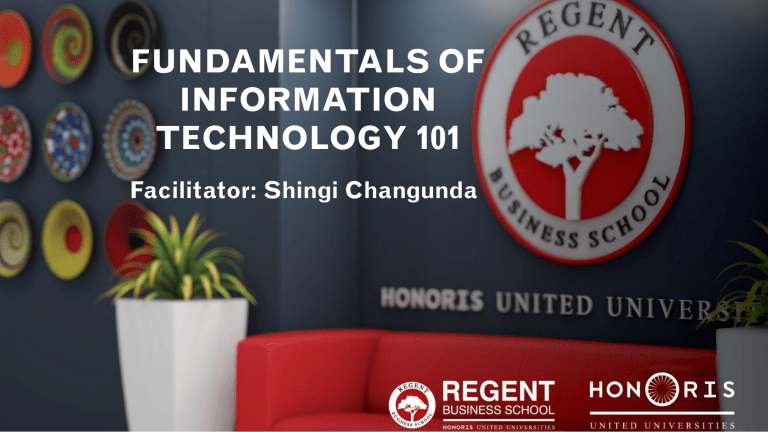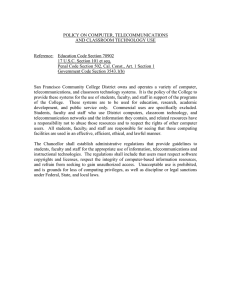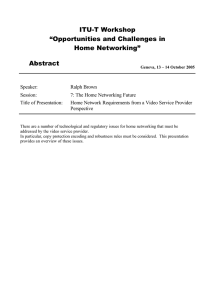
FUNDAMENTALS OF INFORMATION TECHNOLOGY 101 Facilitator: Shingi Changunda Chapter 3 Software 3.2. Software A system is a set of elements or components that interact to accomplish goals. Example: car wash Input: Dirty car, water, liquid soap, car wax Processing mechanism: selecting which cleaning option you want (wash only, wash with wax) and the components (the liquid sprayer, foaming brush and air dryer) interact to create a clean car Output: a clean car Feedback mechanism: check how clean the car is 3.2. Software System software manages the hardware components, e.g. Microsoft Windows Application software consists of programs that support day-to-day business functions and provide users with the information they need. Microsoft Office and Adobe Creative Suite Software Personal Workgroup Enterprise Systems Smartphone, tablet computer, Network operating Server software personal computer and systems mainframe operating Systems workstation operating systems and Application Word processing, Electronic mail, group General ledger, order software spreadsheet, database and scheduling, shared graphics work and collaboration entry, payroll and human resources 3.2. Software An operating system (OS) is a set of programs that controls a computer’s hardware and acts as an interface with application software Combination of PCs, OS and users Single computer & single user Single computer & multiple users Multiple computers & multiple users 4.3.1 Functions Performed by the Operating System The programs that make up the OS perform a variety of activities, including the following: • Control common computer hardware functions • Provide a user interface and manage input/output management • Provide a degree of hardware independence • Manage system memory • Manage processing tasks • Provide networking capability • Control access to system resources • Manage files Common Hardware Functions The OS enables applications to perform a variety of hardware-related tasks, such as the following: • Get input from the keyboard or another input device • Retrieve data from disks • Store data on disks • Display information on a monitor or printer 3.3.2 User Interface and Input/Output Management • A graphical user interface (GUI) displays pictures (called icons) and menus that people use to send commands to the computer system. • GUIs are more intuitive to use than command-based interfaces because they try to anticipate the user’s needs and they provide easy-to-recognise options. Microsoft Windows is one popular operating system with a GUI. • Although GUIs have traditionally been accessed using a keyboard and mouse, as technology developed, people could instead use touch screens and spoken commands. 3.2. Memory management The OS also controls how memory is accessed, maximising the use of available memory and storage to provide optimum efficiency. The memory-management feature of many OSs allows the computer to execute program instructions effectively and to speed processing. 3.3.5. Processing Tasks Task management allocates computer resources to make the best use of each system’s assets allowing for: • Multitasking • Time sharing 3.3.6 Networking Capability Most operating systems include networking capabilities so that computers can join in a network to send and receive data and share computing resources. Operating systems for larger server computers are designed specifically for computer networking environments. 3.3.7 Access to System Resources and Security • The OS needs to provide a high level of security against unauthorised access to the users’ data and programs over the network. • OS usually have a logon procedure. • Access control for various users 3.3.8 File Management • The OS manages files to ensure that files in secondary storage are available when needed and that they are protected from access by unauthorised users. • Many computers support multiple users who store files on centrally located disks or tape drives. The OS keeps track of where each file is stored and who is cleared to access them. 3.3.8 File Management Utility Programs • Utility programs: Type of software that performs a specific task usualy related to managing or maintaining a computer system. • Many utilities are built into operating systems • Utilities are also available as standalone products and security suites • Examples: Antivirus programs, malware removers, middleware Software Issues and Trends Software Bugs A software bug is a defect in a computer program that keeps it from performing as its users expect it to perform. Copyrights and Licenses Most companies aggressively guard and protect the source code of their software from competitors as well as customers. As a result, most software products are protected by law using copyright or licensing provisions. Freeware and Open-Source Software Some software developers are not concerned about profiting from their intellectual property, which has given rise to alternative copyrights and licensing agreements. Software Upgrade Software companies periodically revise their programs. Deciding whether to upgrade to a new version of software can be a challenge for corporations and people with a large investment in software. Chapter 3 Databases 4.2. Databases and Data Modelling A database is an organised collection of facts and information, typically consisting of two or more related data files. Definitions Relational Database: A series of related tables, stored together with a minimum of duplication to achieve consistent and controlled pool of data. Entity: A person, place or thing about whom or about which an organisation wants to store data. Records: A row in a table; all the data pertaining to one instance of an entity. Fields: A characteristic or attribute of an entity that is stored in the database. Primary key: The column or columns that contain values that uniquely identify each row in a table. Foreign key: When a primary key is posted into another table to create a relationship between the two, it is known as a foreign key. 4.2.2. Relationships Between Tables 4.2.3. Designing Relational Databases A database design is also known as a data model or a database schema. It is a list of all the tables in the database, along with all the fields, with any primary and foreign keys identified. The approach has four stages: a) Identify all entities. b) Identify all relationships between entities. c) Identify all attributes. d) Resolve all relationships. Chapter 5 Networks Telecommunications, Networks and the Internet Telecommunications refers to the electronic transmission of signals for communications, by such means as telephone, radio and television. Here is a general model of telecommunications: Guided Transmission Media Types Telecommunication Hardware Hubs connect up to 20 PCs to a network. It may be attached to a server or a backbone connection to a server. A bridge is a networking device that combines numerous communication networks or network segments into a single, aggregate network. A router is a networking device that receives, processes, and sends data packets from one computer network to another. LAN Local Area Networks A network that connects computer systems and devices within a small area, such as an office, home or several floors in a building, is a LAN. Small workgroup network connecting a single server to three PCs and a laser printer Source: Bocij and Hickey, (2015) MAN A Metropolitan Area Network (MAN) is a telecommunications network that connects users and their computers in a geographical area that spans a campus or city. WAN Wide Area Network (WAN) is a telecommunications network that connects large geographic regions. Distributed processing A distributed computer system consists of multiple software components that are on multiple computers, but run as a single system. Client- Server Computing Model The client/server model involves a series of clients, typically desktop PCs, which are the access points for end-user applications. The clients are connected to a more powerful PC or server computer via a local area network within one site of a company, or a wide-area network connecting different sites and/or companies. 5.9. Securing Data Transmission The interception of confidential information by unauthorised individuals can compromise private information. Encryption of data is one approach taken to protect the security of communications over both wired and wireless networks.

